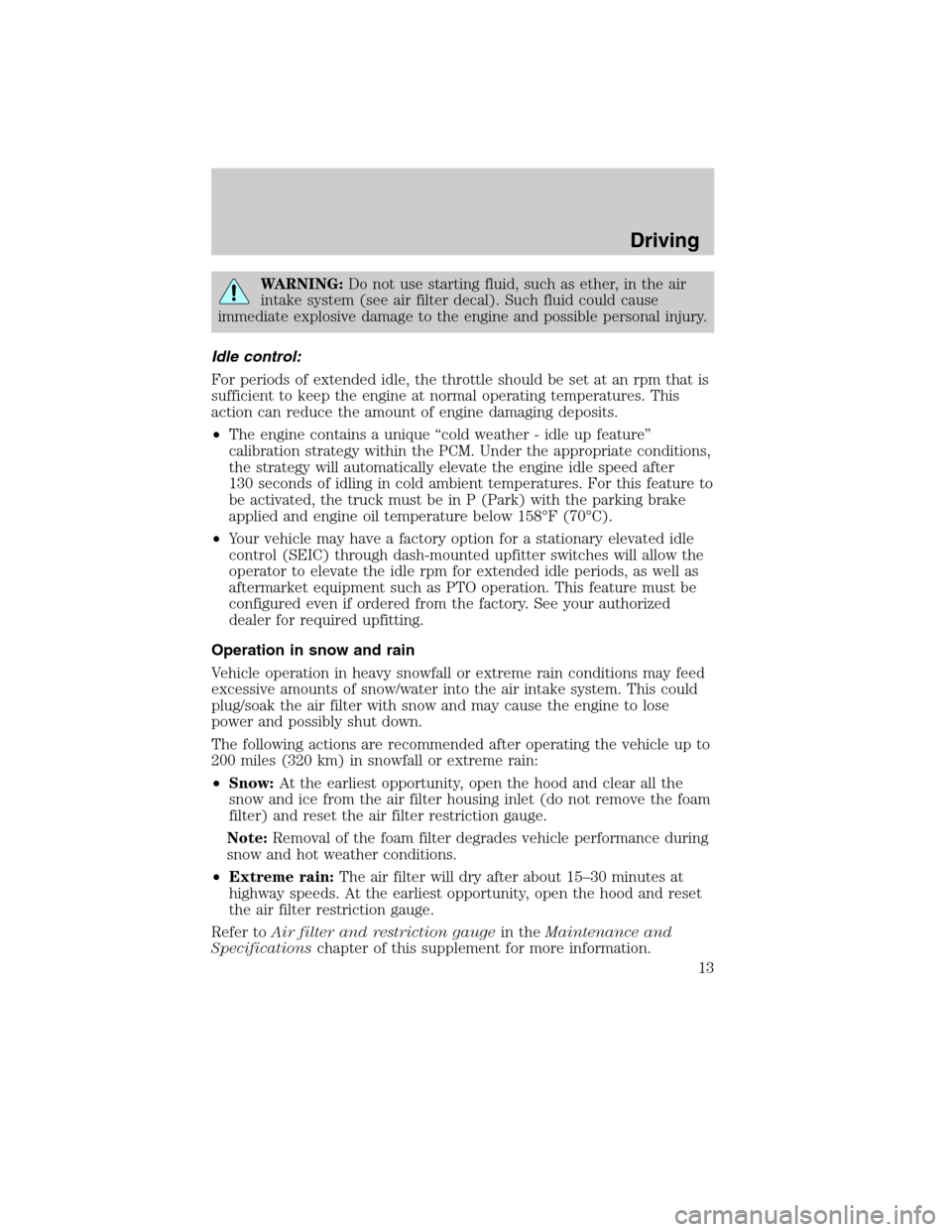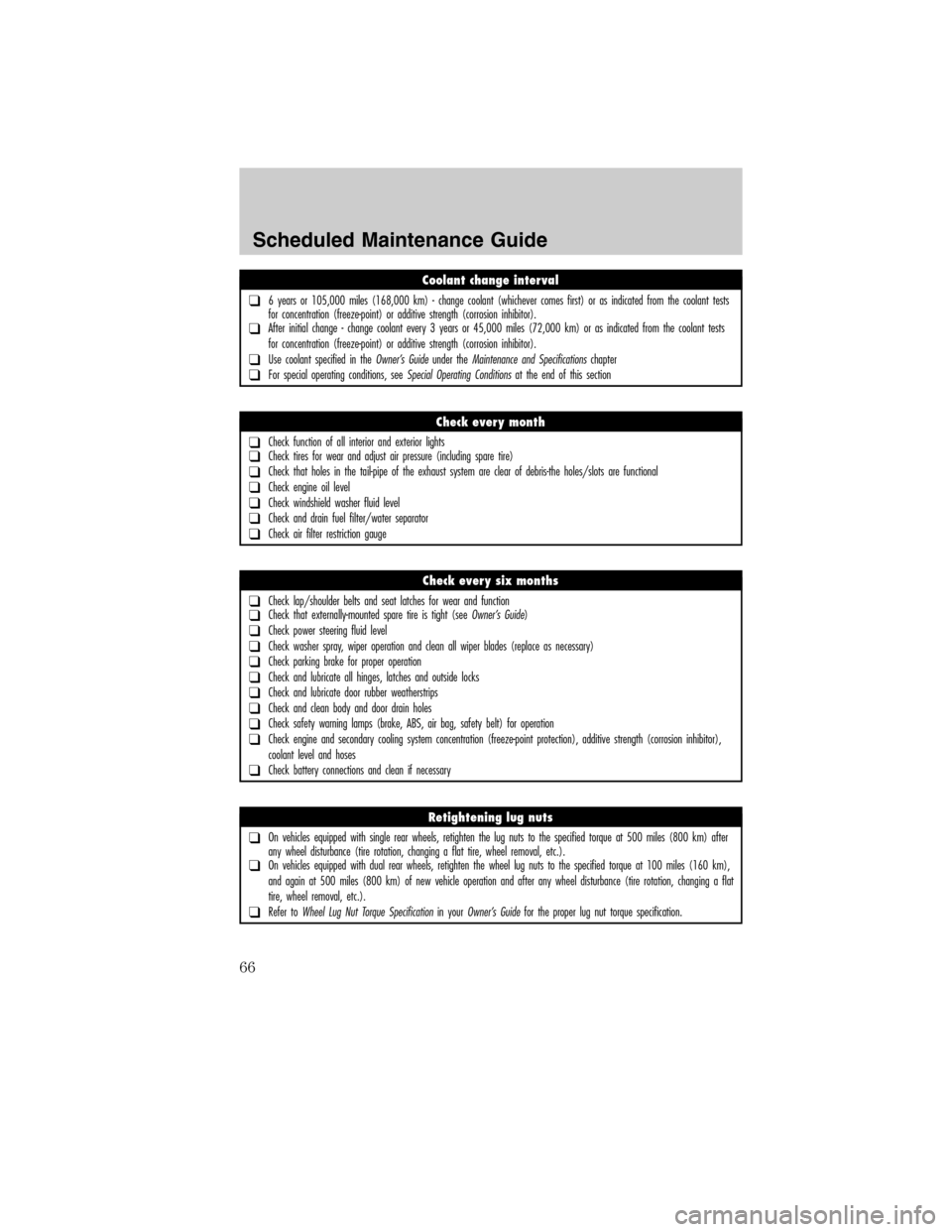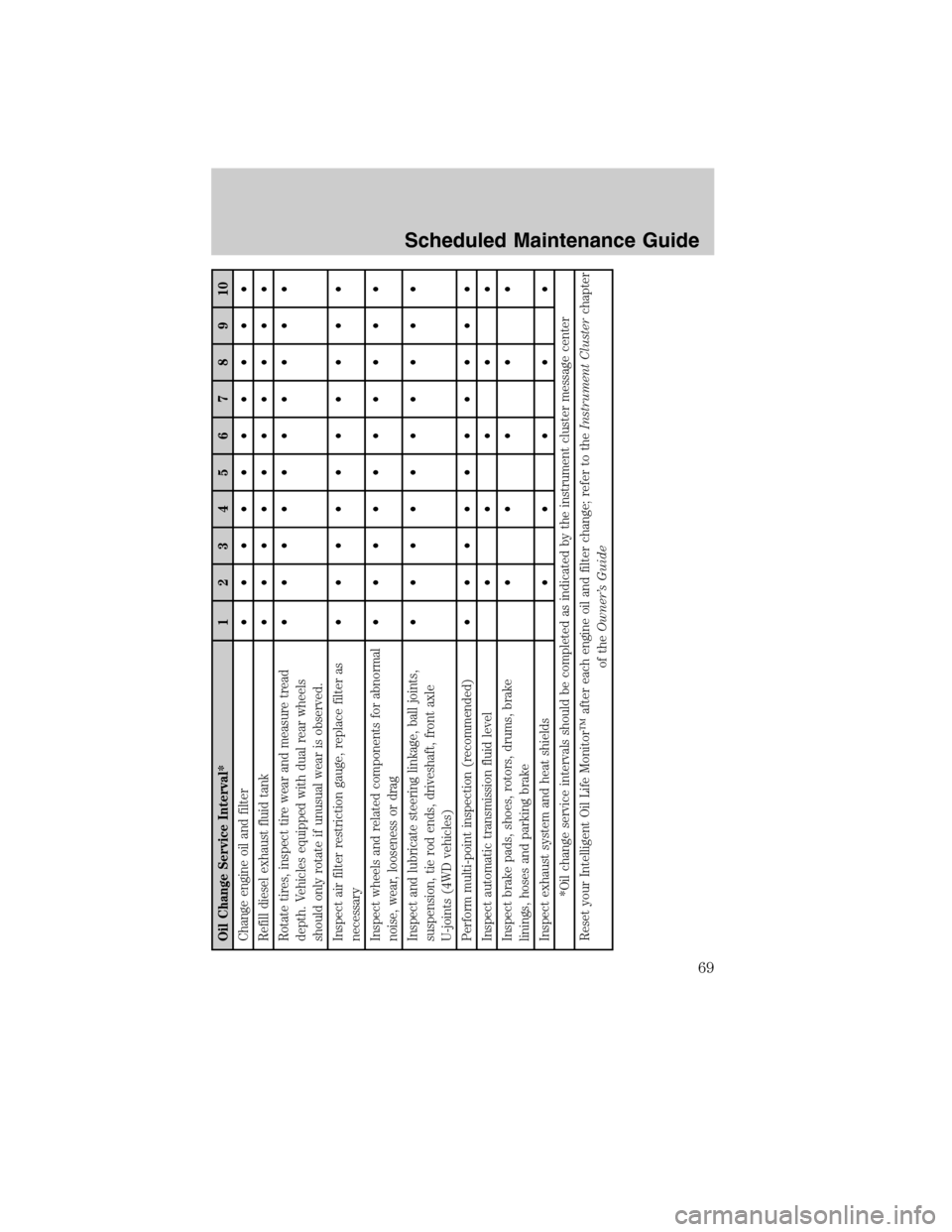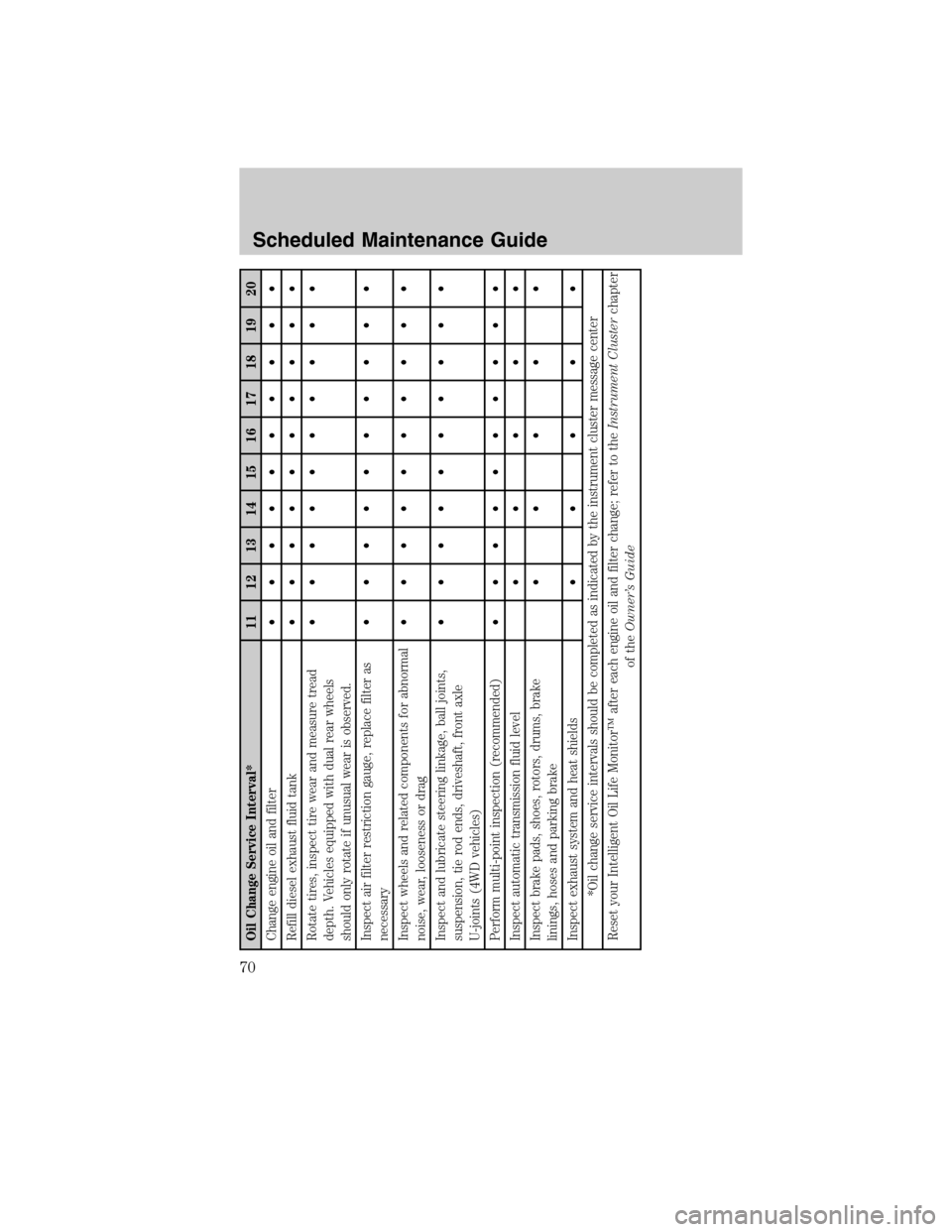2011 FORD SUPER DUTY parking brake
[x] Cancel search: parking brakePage 8 of 90

STARTING THE ENGINE
Read all starting instructions carefully before you start your vehicle.
For temperatures below 32°F (0°C), the use of the correct grade engine
oil is essential for proper operation. Refer toEngine oil specifications
in theMaintenance and Specificationschapter for more information.
Your vehicle may be equipped with a cold weather starting strategy that
prevents severe engine damage by assisting in engine lubrication
warm-up. In extremely cold ambient temperatures, this strategy activates
and prevents the accelerator pedal from being used for 30 seconds after
starting the vehicle. By not allowing the accelerator pedal to be used, the
engine oil is allowed to properly lubricate the bearings preventing engine
damage due to lack of proper lubrication. After the 30 second warm-up
period, the accelerator pedal will be operational again as long as the
pedal is not being pressed when the 30 second time limit expires. When
starting the engine in extremely cold temperatures (-15°F [–26°C]), it is
recommended to allow the engine to idle for several minutes before
driving the vehicle.
Ensure the gearshift lever is in P (Park) and the parking brake is fully
set before you turn the key. Do not press the accelerator during starting.
Engine-driven cooling fan (fan clutch)
Your vehicle is equipped with an engine driven cooling fan drive (also
called a fan clutch). This fan drive changes the fan speed to match the
vehicle’s changing cooling air flow requirements. Fan speed, fan noise
level and fuel consumption all will increase based on the driving
conditions that include trailer towing, hill climbing, heavy loads, high
speed and high ambient temperature, individually or in combination.
The fan drive is designed to provide the minimum fan speed (and
resulting minimum fan noise and fuel consumption) required to meet the
ever changing vehicle cooling air flow requirements. You will hear the
amount of fan noise increasing and decreasing as the engine power
requirements and vehicle driving conditions change as you drive. This is
to be expected as being normal to the operation of your vehicle. High
levels of fan noise might also be heard when your engine is first started,
and should normally decrease after driving for a short time.
Driving
8
2011 Econoline(eco)
Supplement, 1st Printing
USA(fus)
Page 10 of 90

ENGINE IDLE SHUTDOWN (IF EQUIPPED)
Your vehicle may be equipped with an engine idle shutdown system. This
system will automatically shut down your engine when it has been idling
in P (Park) or N (Neutral) for five minutes (parking brake set) or
15 minutes (parking brake not set). When the engine idle shutdown
process has started:
•A chime will sound and the message center will displayENGINE
TURNS OFF IN 30(seconds) and start counting down.
•The 5 or 15 minute timer can be restarted by changing the position of
the accelerator pedal, brake pedal or the park brake within the final
30 seconds.
•When the timer reaches zero, the engine shuts down and the message
center will displayENGINE TURNED OFF.
•One minute after the engine has shut down, the electrical system will
simulate key off, even though the ignition is still in the on position,
initiating normal accessory delay period.
•The ignition must be moved to the off position to reset the system
before restarting the vehicle.
Note:The engine idle shutdown idle timer will not start if:
•The engine is operating in power take-off (PTO) mode.
•The engine coolant temperature is below 60°F (16°C).
•The exhaust emission control device (DPF) is regenerating.
STOPPING THE ENGINE
Turn the ignition to the off position.
To prolong engine life (especially after extended high speed, high
ambient temperature, or high GVW/GCW operation), it is recommended
that a hot engine be idled for 3-5 minutes which will allow the
turbocharged engine to cool down.
COLD WEATHER OPERATION
Changing to a lighter grade engine oil also makes starting easier under
these conditions. Refer toEngine oil specificationsin theMaintenance
and Specificationschapter of this supplement.
Diesel fuel is adjusted seasonally for cold temperatures. Diesel fuel which
has not been properly formulated for the ambient conditions may form
wax crystals which can clog the fuel filters. At temperatures below 20°F
(–7°C), if the engine starts, stalls after a short time, and then will not
Driving
10
2011 Econoline(eco)
Supplement, 1st Printing
USA(fus)
Page 13 of 90

WARNING:Do not use starting fluid, such as ether, in the air
intake system (see air filter decal). Such fluid could cause
immediate explosive damage to the engine and possible personal injury.
Idle control:
For periods of extended idle, the throttle should be set at an rpm that is
sufficient to keep the engine at normal operating temperatures. This
action can reduce the amount of engine damaging deposits.
•The engine contains a unique “cold weather - idle up feature”
calibration strategy within the PCM. Under the appropriate conditions,
the strategy will automatically elevate the engine idle speed after
130 seconds of idling in cold ambient temperatures. For this feature to
be activated, the truck must be in P (Park) with the parking brake
applied and engine oil temperature below 158°F (70°C).
•Your vehicle may have a factory option for a stationary elevated idle
control (SEIC) through dash-mounted upfitter switches will allow the
operator to elevate the idle rpm for extended idle periods, as well as
aftermarket equipment such as PTO operation. This feature must be
configured even if ordered from the factory. See your authorized
dealer for required upfitting.
Operation in snow and rain
Vehicle operation in heavy snowfall or extreme rain conditions may feed
excessive amounts of snow/water into the air intake system. This could
plug/soak the air filter with snow and may cause the engine to lose
power and possibly shut down.
The following actions are recommended after operating the vehicle up to
200 miles (320 km) in snowfall or extreme rain:
•Snow:At the earliest opportunity, open the hood and clear all the
snow and ice from the air filter housing inlet (do not remove the foam
filter) and reset the air filter restriction gauge.
Note:Removal of the foam filter degrades vehicle performance during
snow and hot weather conditions.
•Extreme rain:The air filter will dry after about 15–30 minutes at
highway speeds. At the earliest opportunity, open the hood and reset
the air filter restriction gauge.
Refer toAir filter and restriction gaugein theMaintenance and
Specificationschapter of this supplement for more information.
Driving
13
2011 Econoline(eco)
Supplement, 1st Printing
USA(fus)
Page 66 of 90

Coolant change interval
❑6 years or 105,000 miles (168,000 km) - change coolant (whichever comes first) or as indicated from the coolant tests
for concentration (freeze-point) or additive strength (corrosion inhibitor).
❑After initial change - change coolant every 3 years or 45,000 miles (72,000 km) or as indicated from the coolant tests
for concentration (freeze-point) or additive strength (corrosion inhibitor).
❑Use coolant specified in theOwner’s Guideunder theMaintenance and Specificationschapter
❑For special operating conditions, seeSpecial Operating Conditionsat the end of this section
Check every month
❑Check function of all interior and exterior lights❑Check tires for wear and adjust air pressure (including spare tire)
❑Check that holes in the tail-pipe of the exhaust system are clear of debris-the holes/slots are functional
❑Check engine oil level
❑Check windshield washer fluid level
❑Check and drain fuel filter/water separator
❑Check air filter restriction gauge
Check every six months
❑Check lap/shoulder belts and seat latches for wear and function❑Check that externally-mounted spare tire is tight (seeOwner’s Guide)
❑Check power steering fluid level
❑Check washer spray, wiper operation and clean all wiper blades (replace as necessary)
❑Check parking brake for proper operation
❑Check and lubricate all hinges, latches and outside locks
❑Check and lubricate door rubber weatherstrips
❑Check and clean body and door drain holes
❑Check safety warning lamps (brake, ABS, air bag, safety belt) for operation
❑Check engine and secondary cooling system concentration (freeze-point protection), additive strength (corrosion inhibitor),
coolant level and hoses
❑Check battery connections and clean if necessary
Retightening lug nuts
❑On vehicles equipped with single rear wheels, retighten the lug nuts to the specified torque at 500 miles (800 km) after
any wheel disturbance (tire rotation, changing a flat tire, wheel removal, etc.).
❑On vehicles equipped with dual rear wheels, retighten the wheel lug nuts to the specified torque at 100 miles (160 km),
and again at 500 miles (800 km) of new vehicle operation and after any wheel disturbance (tire rotation, changing a flat
tire, wheel removal, etc.).
❑Refer toWheel Lug Nut Torque Specificationin yourOwner’s Guidefor the proper lug nut torque specification.
Scheduled Maintenance Guide
66
2011 Econoline(eco)
Supplement, 1st Printing
USA(fus)
Page 69 of 90

Oil Change Service Interval* 1 2 345678910
Change engine oil and filter• •••••••••
Refill diesel exhaust fluid tank• •••••••••
Rotate tires, inspect tire wear and measure tread
depth. Vehicles equipped with dual rear wheels
should only rotate if unusual wear is observed.• •••••••••
Inspect air filter restriction gauge, replace filter as
necessary• •••••••••
Inspect wheels and related components for abnormal
noise, wear, looseness or drag• •••••••••
Inspect and lubricate steering linkage, ball joints,
suspension, tie rod ends, driveshaft, front axle
U-joints (4WD vehicles)• •••••••••
Perform multi-point inspection (recommended)• •••••••••
Inspect automatic transmission fluid level•••••
Inspect brake pads, shoes, rotors, drums, brake
linings, hoses and parking brake•••••
Inspect exhaust system and heat shields•••••
*Oil change service intervals should be completed as indicated by the instrument cluster message center
Reset your Intelligent Oil Life Monitor™ after each engine oil and filter change; refer to theInstrument Clusterchapter
of theOwner’s Guide
Scheduled Maintenance Guide
69
2011 Econoline(eco)
Supplement, 1st Printing
USA(fus)
Page 70 of 90

Oil Change Service Interval* 11 12 13 14 15 16 17 18 19 20
Change engine oil and filter• •••••••••
Refill diesel exhaust fluid tank• •••••••••
Rotate tires, inspect tire wear and measure tread
depth. Vehicles equipped with dual rear wheels
should only rotate if unusual wear is observed.• •••••••••
Inspect air filter restriction gauge, replace filter as
necessary• •••••••••
Inspect wheels and related components for abnormal
noise, wear, looseness or drag• •••••••••
Inspect and lubricate steering linkage, ball joints,
suspension, tie rod ends, driveshaft, front axle
U-joints (4WD vehicles)• •••••••••
Perform multi-point inspection (recommended)• •••••••••
Inspect automatic transmission fluid level•••••
Inspect brake pads, shoes, rotors, drums, brake
linings, hoses and parking brake•••••
Inspect exhaust system and heat shields•••••
*Oil change service intervals should be completed as indicated by the instrument cluster message center
Reset your Intelligent Oil Life Monitor™ after each engine oil and filter change; refer to theInstrument Clusterchapter
of theOwner’s Guide
Scheduled Maintenance Guide
70
2011 Econoline(eco)
Supplement, 1st Printing
USA(fus)